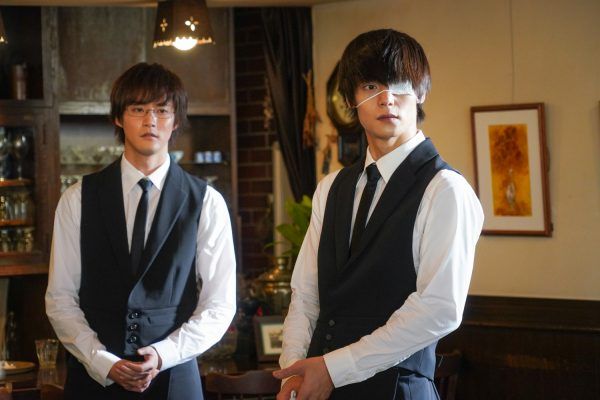Horror has historically been a challenging genre to do in anime. Live-action adaptations of anime are traditionally notoriously bad. What happens when you combine the two, add a dose of Hannibal aesthetics and bromance, but wrap the whole thing in a traditional slice-of-life soap opera? You get Tokyo Ghoul S, of course!
Tokyo Ghoul S is the sequel to 2017’s live-action Tokyo Ghoul, an adaptation of the dark fantasy / horror manga and anime series Tokyo Ghoul. If you’re not familiar with the franchise, you’re out of luck. Tokyo Ghoul S throws you right into its world where humans live alongside ghouls, super-human predators who satisfy their ravenous hunger with our flesh and blood. We follow Ken Kaneki (Masataka Kubota), a college student who also happens to be a half-ghoul since one of the blood-thirsty monsters attacked him. Though the premise is simple enough – Ken is being hunted by a ghoul who is a bit of a foodie and wants to have a taste of Ken – the movie spares no time for newcomers who don’t have any context for what is happening on the screen. All backstory, world-building and character motivation you need you can either get by watching the previous film, or unfortunately get lost.
The first film took its sweet time building its version of Tokyo and introducing the concept of the ghouls before getting to the interesting and action-heavy bits. Tokyo Ghoul S thankfully doesn’t have to do that, so instead we jump right into a nightmarish and horror-heavy opening that introduces us to Shu “The Gourmet” Tsukiyama (Shota Matsuda) a dark, shadowy ghoul with a liking for full face masks. Oh, and he also likes to devour the eyeballs of supermodels like they were popcorn. You see, Tsukiyama is a bit of a foodie in addition to being a ghoul, and so when he hears of a half-man, half-ghoul, he can’t help but grow a particularly sadistic hunger for Ken’s flesh.
Like a teen version of Bryan Fuller’s Hannibal TV show, the bulk of Tokyo Ghoul S deals with Tsukiyama befriending Ken with the intention of killing him, without the latter realizing at first. So begins a strange relationship that is as strange and horrific as it is kind of sweet, with Matsuda doing his best glam version of Mads Mikkelsen’s Hannibal. It’s hard to avoid these comparisons when all the plates of food – particularly those of human origin – are shot like the beautiful and tasty human-meals from the NBC show, with an erotic eye that makes even the most disgusting and grotesque of plates look absolutely stunning. The directing team of Takuya Kawasaki and Hazuhiko Hiramaki let the horror and action scenes shine through vibrant colors and swift and elegant camera movements. The cinematography, aided by a string-heavy score that uses vibrato to create a creepy atmosphere, let the nighttime scenes feel like a thrilling and engaging horror film. If only the action scene could have taken up more of the runtime, this would have been an excellent thriller.
Unfortunately, the fight scenes are used sparingly, and even then they are more subtle than the over-the-top fights from the previous film. Though Tokyo Ghoul S is shorter than its predecessor, the film quickly loses the tension and fast pace it built in the first act by dwelling on the melodrama. The daytime scenes are filmed like a slice-of-life drama, focusing on warm, pastel colors and real subtle movements that let the dialogue carry the film forward. When you go from a bloody, moody action set piece like the clip we previously released right to what is essentially a high-school drama set in college, you’re bound to lose some viewers. This is a problem that’s inherent of many live-action anime and manga adaptations, which add slow and human moments to pad the runtime and make the audience connect deeper with the characters by focusing on the smaller moments. Unfortunately, when the premise promises so much action, and the film even delivers on that promise at times, going back to the college sub-plot feels like a waste.
Mastaka Kubota does a good and improved job as Ken, grounding the character in emotion and making the fantastical elements of the story feel a bit more natural and believable. The real standout is Shota Matsuda as the villainous Gourmet, who devours the entire room every time he walks him, seducing both characters and the camera with arrogance and confidence. Like Mikkelsen’s Hannibal, you clearly know you should hate The Gourmet, but you can’t help for feel a certain fascination or attraction. His relationship with Ken and on-screen chemistry makes for a fascinating, and at times terrifying experience.
Tokyo Ghoul S has a lot to offer for longtime fans of the source material, in particular it’s cat-and-mouse game between two fascinating characters and an ambitious use of special effects that defies the film’s small budget. That being said, the film loses its momentum by quickly diving into melodrama, which ends up as a frustrating moviegoing experience that feels longer than its 100-minute runtime.
Rating: C
Tokyo Ghoul S is now playing in North American theaters with screenings on September 18th, and 20th; be sure to check FUNimation’s page for tickets and showtimes near you.




